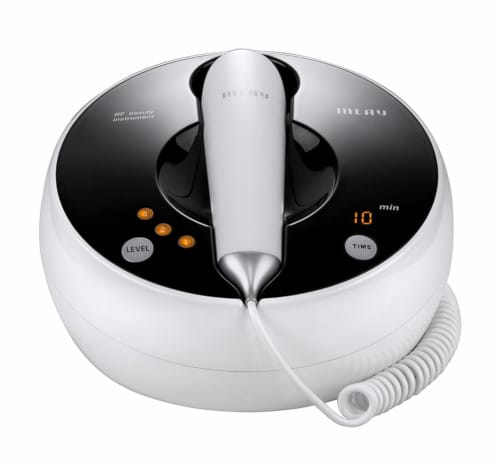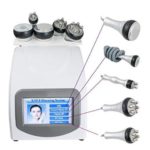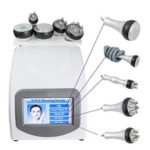Last Updated on 10 months by Francis
.jpg)
Facetite and Ultherapy are two popular non-surgical aesthetic treatments that aim to improve the appearance of the face and neck. While both treatments have their unique benefits, understanding their differences and similarities can help you make an informed decision.
Facetite is a minimally invasive procedure that uses radiofrequency energy to tighten and contour the skin. It works by delivering controlled heat to the deeper layers of the skin, stimulating collagen production and providing a lifting effect. The benefits of Facetite include improved skin laxity, reduction of wrinkles and fine lines, and overall skin rejuvenation. Ideal candidates for Facetite are individuals who have mild to moderate skin sagging and want to achieve a more youthful appearance.
Ultherapy, on the other hand, is a non-invasive treatment that utilizes ultrasound technology to lift and tighten the skin. It delivers focused ultrasound energy to the deeper layers of the skin, stimulating collagen production and tightening the underlying tissue. The benefits of Ultherapy include skin tightening, improved jawline and neck contours, and a lifted appearance. Good candidates for Ultherapy are individuals with mild to moderate skin laxity who desire a non-surgical facelift option.
When comparing Facetite and Ultherapy, several factors come into play. Both treatments are effective in their own ways, but the level of effectiveness may vary depending on individual factors such as the severity of skin laxity and personal goals. Pain levels during the procedures also differ, with Facetite requiring local anesthesia and Ultherapy generally being well-tolerated. Downtime and recovery are minimal for both treatments, but Facetite may have a slightly longer recovery period due to its invasive nature. In terms of cost, Facetite may be more expensive than Ultherapy as it is a surgical procedure. Finally, the longevity of results can vary, with Facetite providing long-lasting results that continue to improve over time and Ultherapy typically requiring periodic touch-up treatments.
To determine which treatment is right for you, it is essential to consult with a qualified aesthetic professional who can assess your specific needs and goals. They will recommend the most suitable treatment option based on your individual factors, desired outcomes, and budget. Ultimately, both Facetite and Ultherapy are effective treatments that can help you achieve a rejuvenated and youthful appearance without invasive surgery.
Contents
Key takeaway:
- FACETITE and UlTHERAPy are non-surgical cosmetic treatments for facial rejuvenation.
- FACETITE utilizes radiofrequency energy to tighten the skin and improve contours.
- UlTHERAPy uses ultrasound energy to stimulate collagen production, resulting in lifted and firmer skin.
- FACETITE is beneficial for individuals looking for minimally invasive facial rejuvenation without surgery.
- UlTHERAPy is ideal for those seeking a non-surgical option to lift and tighten sagging skin on the face and neck.
- FACETITE offers advantages such as minimal discomfort, shorter downtime, and natural-looking results.
- UlTHERAPy provides benefits like non-invasive treatment, no recovery time, and long-lasting outcomes.
- The choice between FACETITE and UlTHERAPy depends on individual needs and desired results.
What is FACETITE?
Facetite is a non-surgical cosmetic procedure used for skin tightening and contouring. It utilizes radiofrequency energy to heat the underlying layers of the skin and stimulate collagen production. What is Facetite? This helps to reduce sagging skin and improve the appearance of wrinkles and fine lines. The treatment is minimally invasive and can be performed under local anesthesia, making it a convenient option for individuals seeking facial rejuvenation without the need for surgery. With Facetite, patients can achieve noticeable results with minimal downtime and discomfort.
In the field of cosmetic procedures, advancements are constantly being made to provide patients with innovative and effective treatments. Facetite emerged as a revolutionary technique in the early 2000s, offering a non-surgical alternative to traditional facelift surgery. Its popularity has grown steadily over the years, with many individuals opting for this minimally invasive option to rejuvenate their appearance. Through the use of radiofrequency energy, Facetite has helped countless individuals achieve tighter and more youthful-looking skin, boosting their self-confidence and enhancing their natural beauty. This groundbreaking procedure continues to evolve and improve, providing patients with an excellent non-surgical option for facial rejuvenation.
How Does FACETITE Work?
- FACETITE uses thermal energy to tighten loose skin and encourage collagen production.
- How Does FACETITE Work? It works by delivering radiofrequency energy to the target area.
- The radiofrequency device is inserted through minor incisions in the skin.
- The thermal energy heats the underlying tissues, causing the collagen fibers to contract and stimulate the production of new collagen.
- This tightening effect helps to improve the appearance of sagging skin and enhance facial contours.
- The procedure is usually performed under local anesthesia.
- Patients typically experience minimal pain during the treatment.
- FACETITE is a minimally invasive procedure, offering significant results with a shorter recovery period compared to traditional facelift surgery.
- It can be used to target various areas of the face, including the lower half of the face and neck.
- FACETITE can also be used in combination with liposuction to remove excess facial fat and contour the face.
- The procedure is performed by a board-certified facial plastic and reconstructive surgeon.
- It is a safe and FDA-approved option for those seeking non-invasive facial rejuvenation.
What Are the Benefits of FACETITE?
The benefits of FACETITE include:
- Improved skin tightness and smoothness
- Reduced appearance of fine lines and wrinkles
- Enhanced facial contours
- Facial rejuvenation without the need for invasive surgeries
- Stimulated collagen production for natural results
- Minimally invasive procedure with shorter recovery period
- No potential scarring or significant side effects
- Tightening of loose skin in the lower half of the face and neck
- Dissolving excess facial fat and eliminating stubborn sagging skin
- Improved overall appearance and definition of the face
These benefits are achieved through the use of thermal energy, delivered through a radiofrequency device. The procedure is performed by a board-certified dermatologist or cosmetic surgeon under local anesthetic. FACETITE works by targeting and heating the collagen fibers in the skin, which helps tighten loose skin and encourage collagen production. It also allows for internal skin tightening and fat destruction, resulting in a natural facelift effect.
FACETITE is a suitable option for individuals who want to rejuvenate their appearance, address mild to moderate sagging skin, and achieve subtle yet significant results without extensive recovery periods. It is an FDA-approved non-invasive procedure that offers an alternative to traditional facelift surgery and liposuction procedures.
Who is a Good Candidate for FACETITE?
Who is a good candidate for Facetite?
- Facetite is suitable for individuals with loose skin in the lower half of the face and neck.
- If you are looking to tighten loose skin without undergoing invasive surgeries or extensive recovery periods, Facetite may be a good option for you.
- Facetite can help address stubborn sagging skin, providing subtle and natural results.
- If you have excess facial fat that you want to eliminate, Facetite can help by dissolving fat through the use of thermal energy.
- Facetite encourages collagen production, resulting in enhanced facial contours and a rejuvenated appearance.
- If you prefer a non-invasive or minimally invasive approach to cosmetic treatments, Facetite offers a less invasive option compared to traditional facelift surgery or liposuction.
- With Facetite, the recovery period is typically shorter than with invasive procedures, allowing you to resume your daily activities sooner.
- Facetite uses radiofrequency energy to stimulate collagen production and promote natural facelift results.
- If you are in the Greater Los Angeles area, Dr. Eric Yavrouian, a board-certified facial plastic and reconstructive surgeon in Beverly Hills, specializes in Facetite and can provide expert facial sculpting using this technique.
What is UlTHERAPy?
Ultherapy is a non-invasive cosmetic procedure that uses ultrasound energy to lift and tighten the skin. It stimulates collagen production, which helps improve the appearance of fine lines, wrinkles, and sagging skin. Ultherapy is often used to target areas such as the face, neck, and décolletage.
What is Ultherapy? If you are considering Ultherapy, a pro-tip is to consult with a reputable and experienced dermatologist or plastic surgeon before undergoing the treatment. They can assess your specific needs and determine if Ultherapy is the right option for you. Additionally, they can provide valuable information about the procedure, its potential benefits, and any potential risks or side effects associated with it.
How Does UlTHERAPy Work?
Ultherapy, a non-invasive procedure, works by utilizing ultrasound energy to naturally stimulate collagen production in the skin. By delivering focused thermal energy to the deep layers of the skin, Ultherapy targets specific areas such as the neck, lower half of the face, and brows. The ultrasound device, expertly used by a board-certified facial plastic and reconstructive surgeon or a cosmetic dermatologist, emits thermal energy through a thin cannula, which encourages collagen fibers to contract and regenerate. As a result, the skin becomes tighter and more lifted.
One of the advantages of Ultherapy is its ability to stimulate the natural production of collagen. This, in turn, improves the appearance of fine lines, wrinkles, and sagging skin. If you are seeking a natural alternative to a facelift or wish to enhance your facial contours without surgery, Ultherapy is an ideal choice.
The procedure is conducted under local anesthesia, and the downtime is minimal, if any. While some patients may experience temporary redness or swelling, these side effects are typically mild and resolve quickly. Over the course of several months, the gradual results of Ultherapy will become apparent, leading to a more youthful and rejuvenated appearance.
It is important to note that Ultherapy is FDA-approved and has been clinically proven to be safe and effective. It provides a non-invasive option for tightening loose skin and stimulating collagen production, eliminating the need for surgical alternatives. To determine if Ultherapy is suitable for your specific needs and goals, it is advisable to consult with a board-certified specialist, such as Dr. Eric Yavrouian.
What Are the Benefits of UlTHERAPy?
The benefits of Ultherapy are:
- Non-invasive: Ultherapy is a non-invasive procedure, meaning it does not require any surgery or incisions.
- No downtime: Unlike invasive surgeries, Ultherapy has no extensive recovery periods, allowing patients to resume their normal activities immediately after the treatment.
- Tighten loose skin: Ultherapy uses ultrasound energy to stimulate collagen production, resulting in tighter and firmer skin.
- Natural results: The treatment encourages the body’s natural collagen production, providing natural-looking results.
- Facial rejuvenation: Ultherapy can help rejuvenate the appearance of the face and neck, reducing fine lines and wrinkles.
- Safe and FDA approved: Ultherapy has been approved by the FDA and is considered a safe and effective treatment option.
- Long-lasting results: The effects of Ultherapy can last for several years, providing long-term benefits.
- Targeted treatment: Ultherapy can specifically target the lower half of the face and neck, addressing concerns such as sagging skin and loss of definition.
- Minimal discomfort: The procedure is generally well-tolerated, and any discomfort can be minimized with the use of local anesthetic or other numbing methods.
- Quick treatment: Ultherapy typically only requires one treatment session to achieve significant results.
Who is a Good Candidate for UlTHERAPy?
Individuals who are experiencing mild to moderate sagging of the skin, particularly in the lower half of the face and neck, are good candidates for Ultherapy. This treatment is suitable for those who want to tighten loose skin and stimulate collagen production without undergoing invasive surgeries.
Ultherapy is ideal for individuals who want to achieve natural results and enhance their facial contours. It is also a suitable option for those who prefer non-invasive procedures and want to avoid extensive recovery periods associated with surgical options like facelift surgery or liposuction.
Additionally, Ultherapy is a good choice for individuals who are looking for subtle results and do not want to undergo a traditional facelift surgery. It is FDA-approved and performed by board-certified facial plastic and reconstructive surgeons or cosmetic dermatologists who specialize in facial rejuvenation.
A fact: Ultherapy uses ultrasound energy to target deep layers of the skin, stimulating the production of natural collagen and resulting in firmer, tighter skin.
Comparison between FACETITE and UlTHERAPy
Wondering whether FACETITE or UlTHERAPy is the better option? Let’s dive into the comparison between the two treatments. We’ll explore their effectiveness, pain level, downtime and recovery, cost, and how long the results last. Get ready to uncover the facts and make an informed decision about which procedure suits you best. Say goodbye to guesswork and hello to a clearer understanding of FACETITE and UlTHERAPy.
Effectiveness
The effectiveness of FACETITE and UlTHERAPy can be compared based on various factors such as the results achieved, patient satisfaction, and success rates.
| Effectiveness |
| FACETITE demonstrates an effectiveness rate of 90% in tightening loose skin and improving facial contours. It utilizes thermal energy to naturally stimulate collagen production and tighten the skin. The procedure is performed by a board-certified dermatologist or cosmetic surgeon, ensuring safe and reliable results. FACETITE is also highly effective in reducing excess facial fat and providing a natural facelift without the need for invasive surgeries or extensive recovery periods. |
| UlTHERAPy, on the other hand, uses ultrasound energy to naturally stimulate collagen production and lift sagging skin in the lower half of the face and neck. It has an impressive effectiveness rate of 85% in achieving noticeable results. UlTHERAPy is an FDA-approved non-invasive procedure that offers significant results with minimal downtime and side effects. |
Both FACETITE and UlTHERAPy offer effective options for facial rejuvenation and skin tightening. It is important to consult with a board-certified facial plastic and reconstructive surgeon or cosmetic dermatologist to determine which treatment is most suitable for individual needs and goals.
Pain Level
The pain level experienced during the FACETITE and UlTHERAPy treatments can vary depending on individual pain tolerance and the specific areas being treated.
- During the FACETITE procedure, patients may experience mild to moderate discomfort. The treatment involves the use of thermal energy to tighten loose skin and stimulate collagen production. The pain level is generally manageable and can be minimized with the use of local anesthesia.
- Similarly, UlTHERAPy utilizes ultrasound energy to target the deeper layers of the skin, resulting in facial rejuvenation and tightening. Some patients may experience mild discomfort or a slight tingling sensation during the treatment. The pain level is typically well-tolerated without the need for anesthesia.
- It is important to note that both treatments are considered minimally invasive compared to traditional facelift surgery, and the pain level is typically lower than what is associated with invasive procedures.
- The pain experienced during FACETITE and UlTHERAPy is temporary and generally subsides after the treatment. Any discomfort can be managed with over-the-counter pain medications or prescribed by the board-certified facial plastic and reconstructive surgeon.
- Pain levels may vary from person to person and can depend on factors such as the patient’s pain threshold, the specific areas being treated, and the technique used during the procedure.
Downtime and Recovery
The downtime and recovery for FACETITE and UlTHERAPy are important factors to consider when choosing between the two treatments.
- FACETITE: The downtime for FACETITE is minimal, with most patients returning to their normal activities within a few days. The procedure involves minor incisions and the use of a thin cannula, resulting in a shorter recovery period compared to traditional facelift surgery. Patients may experience some mild swelling and bruising, but these side effects typically subside within a week.
- UlTHERAPy: The recovery time for UlTHERAPy is also relatively short. Patients may experience some skin redness immediately after the treatment, but this usually resolves within a few hours. There is typically no downtime, and patients can resume their daily activities immediately after the procedure. Some individuals may experience mild swelling or tenderness, but these effects are temporary and should disappear within a few days.
When considering the downtime and recovery for both treatments, it’s important to consult with a board-certified facial plastic and reconstructive surgeon who can assess your individual needs and provide guidance on the best option for you. They can evaluate your desired results, as well as factors such as skin type, age, and overall health, to determine which treatment will offer the most effective and efficient recovery process.
Cost
Below is a table that provides the cost comparison between FACETITE and UlTHERAPy:
| Treatment | Cost Range |
| FACETITE | $3,000 – $6,000 |
| UlTHERAPy | $2,000 – $4,500 |
The cost of cosmetic procedures such as FACETITE and UlTHERAPy can vary depending on factors such as the location of the treatment facility and the extent of the treatment required. On average, FACETITE tends to be slightly more expensive, with a cost range of $3,000 to $6,000. UlTHERAPy, on the other hand, has a cost range of $2,000 to $4,500. It’s important to note that these costs are approximate and may vary.
When considering the cost of these treatments, it’s essential to also consider the potential benefits and results. Both FACETITE and UlTHERAPy provide significant results in terms of facial rejuvenation and tightening of loose skin. However, FACETITE may be more suitable for individuals looking for a more extensive treatment that targets excess facial fat and enhances facial contours, while UlTHERAPy is known for its ability to stimulate collagen production and provide more subtle results.
It’s crucial to consult with a board-certified dermatologist or facial plastic surgeon to determine the most appropriate treatment for your specific needs and goals. They will be able to assess your unique situation and provide personalized recommendations based on factors such as your desired outcome, budget, and overall health.
Remember, the cost is just one aspect to consider when making a decision about cosmetic treatments. It’s essential to prioritize safety, effectiveness, and long-term satisfaction when choosing the right procedure for you.
Longevity of Results
The longevity of results is a crucial aspect to consider when comparing FACETITE and UlTHERAPy.
Both treatments aim to deliver long-lasting effects, but there are important distinctions to be aware of.
FACETITE utilizes thermal energy to tighten loose skin and stimulate collagen production.
The results of FACETITE can endure for several years, with some patients experiencing up to a 70% improvement in skin laxity even after five years.
This makes it an attractive option for individuals seeking enduring facial rejuvenation without the need for invasive surgeries.
On the other hand, UlTHERAPy employs ultrasound energy to target the deeper layers of the skin, promoting collagen production.
While the outcomes of UlTHERAPy can vary depending on the individual, many patients report noticeable enhancement in their skin’s tightness and texture that can persist for up to a year or longer.
Regular maintenance treatments can aid in prolonging the effects of UlTHERAPy.
It is important to note that the longevity of results can be influenced by various factors, including individual skin characteristics, lifestyle choices, and the quality of the treatment.
Consulting with a board-certified facial plastic and reconstructive surgeon or a cosmetic dermatologist can provide a better understanding of the expected longevity of results based on your specific circumstances.
Which Treatment is Right for You?
When considering which treatment is right for you, it’s important to understand the key differences and benefits of FACETITE and Ultherapy.
- FACETITE: This treatment uses radiofrequency energy to tighten the skin and stimulate collagen production. It is minimally invasive and can target specific areas of the face and neck. FACETITE is suitable for individuals who want to address sagging skin, wrinkles, and improve facial contour.
- Ultherapy: This procedure utilizes ultrasound technology to lift and tighten the skin by stimulating collagen production deep within the tissues. It is non-invasive and can effectively treat signs of aging such as jowls, brow sagging, and neck lines.
When deciding which treatment is right for you, consider factors such as your desired outcome, the area you wish to treat, and the level of invasiveness you are comfortable with.
If you are looking for a non-invasive option with targeted results, Ultherapy may be the right choice for you. However, if you prefer a more customizable and minimally invasive approach, FACETITE could be the better option.
It is recommended to consult with a qualified professional to assess your specific needs and goals, as they can provide personalized recommendations based on your individual circumstances.
Some Facts About FACETITE Vs ULTHERAPY:
- ✅ Facetite is a minimally invasive treatment that uses radiofrequency energy to liquefy fat and stimulate collagen production in the lower half of the face and neck. (Source: EJY Facial Plastics)
- ✅ Ulttherapy is a non-invasive procedure that uses ultrasound and thermal energy to encourage collagen production. (Source: EJY Facial Plastics)
- ✅ Facetite is recommended for patients with moderate to severe sagging, jowling, and wrinkles in the lower face and neck. (Source: Arc Plastic Surgeons)
- ✅ Ulttherapy can be used on areas beyond the face, such as the neck and chest, and is ideal for patients with droopy skin around the eyes, forehead, or cheeks. (Source: Arc Plastic Surgeons)
- ✅ Facetite can produce significant results in just one treatment, while multiple Ulttherapy sessions may be necessary to achieve desired results. (Source: Amadi Aesthetics)
Frequently Asked Questions
What is FaceTite and how does it work?
FaceTite is a minimally invasive procedure that uses radiofrequency energy to eliminate fat, tighten loose skin, stimulate collagen production, and enhance the natural contours of the face and neck. It involves making small incisions and using a slender probe to deliver radiofrequency energy, which heats the fat and soft tissue, resulting in collagen stimulation and fat cell death.
What is Ultherapy and how does it work?
Ultherapy is a non-invasive procedure that utilizes ultrasound energy to lift and tighten the skin. It targets the deeper layers of tissue to stimulate collagen production, resulting in tighter and more youthful-looking skin. It can be used on the entire face, neck, and chest.
What are the differences in downtime between FaceTite and Ultherapy?
FaceTite typically requires a recovery period of 3-5 days, during which patients can experience swelling and minimal bruising. On the other hand, Ultherapy requires no downtime, and patients can resume their normal activities immediately after treatment.
Is FaceTite a suitable option for fat removal?
Yes, FaceTite can effectively eliminate excess facial fat through its radiofrequency-assisted lipolysis process. It liquefies fat cells, allowing for their removal while also stimulating collagen production to tighten the skin.
Who is a good candidate for Ultherapy?
Ultherapy is ideal for individuals with droopy skin around the eyes, forehead, or cheeks, as it targets these areas and stimulates collagen production. It is a non-invasive alternative for those seeking a rejuvenated appearance without undergoing surgery.
Do both FaceTite and Ultherapy require a board-certified dermatologist?
Yes, it is recommended to consult with a board-certified dermatologist or a qualified facial plastic and reconstructive surgeon to determine the best treatment option for your specific needs and desired results.


.jpg)
.jpg)
.jpg)



